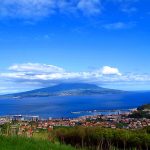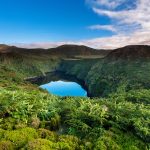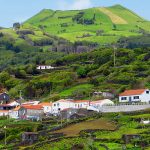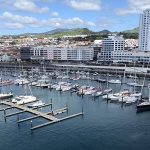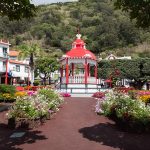About Azores
The Archipelago of the Azores is located in the blue Atlantic Ocean, between two continents. All the nine islands of the Azores Archipelago are of volcanic origin and are located roughly between 37° and 40° north latitude and 25° and 31° west longitude, with the island of Flores marking the westernmost border of the European continent. 244,780 people (2008 data) live in the 2,325 sq. of this island territory, which is part of the Portuguese state and constitutes the Autonomous Region of the Azores.
The islands of the archipelago are divided in three geographical groups: the Eastern Group, comprising Santa Maria and São Miguel, the Central Group, including Terceira, Graciosa, São Jorge, Pico and Faial, and the Western Group, composed by Corvo and Flores. The Azores, along with the archipelagos of Madeira, Canary Islands and Cape Verde, constitute the biogeographic region of Macaronesia, a name which means “fortunate islands” for those who live there and visit them.
HISTORY: The Portuguese arrived in 1427 with the discovery of the island of Santa Maria. Due to its strategic geographic position, the archipelago was to become one of the axis of navigation between Europe, the Orient and America during the course of the 16th and 17th centuries. Having constituted an integral part of Portugal from the very outset, today the Azores is an autonomous region endowed with its own parliament and government.
FLORA & FAUNA: There are over 900 plants species in the Azores, many are relics from the “Laurissilva” cloud forest of the Tertiary period. This makes the islands a natural botanic garden of great interest to all plant lovers. Around 60 species are endemic, including Juniper, tree Heathers, Azorean Holly, Azorean Laurustinus, “Azorina vidalii”, “Picconia azorica”, African box wood, Azores Cherry Laurel, and more. Azorean birds are one of the main attractions in the region, particularly the “priolo” (Azorean Bullfinch, an endemic species), plus the Buzzard, Monteiro Storm Petrel, Cory’s Shearwater, Cliff Pigeon and common and Rosette Tern. The seas surrounding the Azores are rich in hundreds of species of fish and mollusks, as well as harboring large whales and dolphins. The islands are therefore perfect for divers.
LANDSCAPE: Each of the nine islands of the Azores has its own charm and its own distinctive landscapes. They also have a number of things in common - lush green countryside and colourful flowers, volcanic phenomena such as crater lakes at the bottom of “caldeiras”, plus mysterious caves, rock clefts and tunnels and, in the case of Pico island, a majestic mountain. To visit the Azores is to enter a landscape unspoiled by human interference, a stunning environment that brings you closer to nature.
GEOLOGY & NATURE: The Azores evolved from volcanic eruptions over many millennia; and all round the islands are examples of curious volcanic phenomena. There are rounded craters or “caldeiras”, often filled with lakes, plus caves and deep tunnels formed by the eruptions. Ancient black lava covers many surfaces and the islands, ranging from shiny obsidian to soft and porous pumice stones with steam from bubbling hot springs. On all nine islands, there are dozens of natural reserves, protected landscape areas and parks. These are part of the Regional Government’s programme to preserve the archipelago’s ecosystems. In recognition of this, the Azores has recently won a special commendation in the European Tourism and the Environment Awards.
CULTURAL HERITAGE: Many of the island’s churches bear witness to the first period settlement. The 16th and 17th centuries were times of intensive building in the Azores, and left us interesting examples of popular, military and religious art, particularly in baroque style. The character of buildings was often adapted to suit the raw materials available, as well as reflecting the island’s distance from the cultural centers of Europe. The 16th century town of Angra do Heroísmo (on the island of Terceira), was the first urban centre built in the Atlantic. Today, its well preserved churches, palaces and fortress have earned it UNESCO World Heritage status. UNESCO has also recognized the cultural landscape of vineyards on the island of Pico, which are situated on old lava covered fields. Over the centuries, this rocky land has been transformed into wine producing soil protected by a vast network of stone walls. The museums of art and ethnography, together with the popular architecture of each island are also valuable parts of the region’s cultural heritage. They provide us with ways of discovering Azorean history and the life of its people throughout the centuries.
GASTRONOMY: Food lovers will appreciate the varied traditional cuisine of the Azores. For example, if you like your fish straight out of the sea, then these islands will make the perfect holiday. If you also like meat, try the “Cozido das Furnas”, a dish boiled with volcanic steam. Main courses and sweet puddings come in many varieties, and fine cheeses are locally produced, particularly on São Jorge island. Home grown fruit includes pineapple and tropical passion fruit, while perfumed tea grows on the island of S. Miguel, in the only tea plantations in Europe. When it comes to complementing your meal with a drink, be sure to try the local red and white wines, plus the “aguardente” (firewater) from Graciosa island, Biscoitos wine from Terceira island and of course the “verdelho” wine from Pico.

